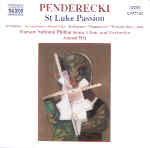Penderecki’s gripping St. Luke Passion (1966) takes the Passions of Bach as its models, refashioning them in an unrelentingly modernist 20th-century language. The boldly original choral writing (including such astonishing voicings as the Tibetan monk-like growling that features throughout the work) and visceral orchestral effects powerfully relay the grandeur and tragedy of the Crucifixion story. However, it’s not necessary to be a believer to experience Penderecki’s work, as the St. Luke Passion can be greatly enjoyed for its purely musical merits.
Much of the orchestral style will be recognizable to anyone familiar with late-20th-century cinema: the otherworldly brass clusters in “Et viri, qui tenebant illum” would later turn up in John Williams’ score for Close Encounters of the Third Kind, while “Comprehendentes autem cum” features a nerve-wracking string-twittering effect that has been adopted for many a scene depicting threatening rodents or insects. Interestingly, one of the most memorable sections of the St. Luke Passion is its quietest–the a cappella choral Stabat Mater, which slowly builds its dissonant tension only to be released in an unexpected yet seemingly inevitable D major chord.
Conductor Antoni Wit leads a stirring rendition aided by impassioned solo performances (with Izabella Klosinska and Romuald Tesarowicz especially memorable), while the Warsaw National Philharmonic Choir and Orchestra give fully committed realizations of this masterpiece. Naxos’ clear, spacious recording delivers it all with powerful, realistic impact. Magnificent! [5/3/2004]
































